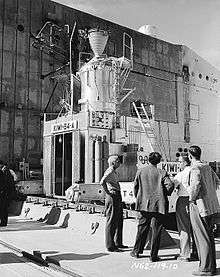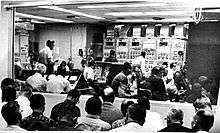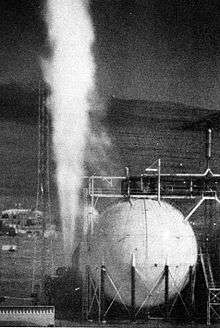NERVA

The Nuclear Engine for Rocket Vehicle Application (NERVA) was a U.S. nuclear thermal rocket engine development program that ran for roughly two decades. NERVA was a joint effort of the U.S. Atomic Energy Commission (AEC) and NASA, managed by the Space Nuclear Propulsion Office (SNPO) until both the program and the office ended at the end of 1972.
NERVA demonstrated that nuclear thermal rocket engines were a feasible and reliable tool for space exploration, and at the end of 1968 SNPO certified that the latest NERVA engine, the NRX/XE, met the requirements for a human mission to Mars. Although NERVA engines were built and tested as much as possible with flight-certified components and the engine was deemed ready for integration into a spacecraft, much of the U.S. space program was cancelled by Congress before a manned mission to Mars could take place.
NERVA was considered by the AEC, SNPO and NASA to be a highly successful program; it met or exceeded its program goals. Its principal objective was to "establish a technology base for nuclear rocket engine systems to be utilized in the design and development of propulsion systems for space mission application".[1] Virtually all space mission plans that use nuclear thermal rockets use derivative designs from the NERVA NRX or Pewee.
History
Project Rover
Los Alamos Scientific Laboratory began researching nuclear rockets in 1952, accelerating into Project Rover in 1955 when the deputy director of Lawrence Livermore National Laboratory, Herbert York, postulated a way to shrink reactor weights considerably. By 1961, after unexpectedly fast-paced progress on the part of Project Rover, NASA's Marshall Space Flight Center began to use nuclear thermal rockets in their mission plans. Marshall planned to use a nuclear-powered rocket from Los Alamos to power a RIFT (Reactor-In-Flight-Test) nuclear stage to be launched as early as 1964, and the need for planning and oversight led to the formation of the Space Nuclear Propulsion Office. SNPO was formed so that the AEC and NASA could work together, and H. B. "Harry" Finger was selected as its first director. Finger made a decision to delay RIFT, and he defined strict objectives for nuclear rocket engines to achieve before RIFT would be allowed.
NERVA engine development

Finger then immediately selected Aerojet and Westinghouse to develop the NERVA engine. SNPO would depend on what was then known as Los Alamos Scientific Laboratory to supply technology for NERVA rocket engines as part of Project Rover. SNPO chose the original 825 second 330 kilonewtons (75,000 lbf) KIWI-B4 nuclear thermal rocket design, named after the Kiwi, a flightless bird native to New Zealand, as the baseline for the 130 cm (52 in) (6.7 m (22 ft) from thrust structure to nozzle bottom) NERVA NRX (Nuclear Rocket Experimental). Phase 2 of Project Rover became called Phoebus, and Phase 3 was known as Pewee, demonstrating much higher power (4000 MW), power density and long-lived fuels, but these programs did not make their way to NERVA. Working NERVA designs (termed NERVA NRX) were based on KIWI; by the time Pewee started testing, the Apollo program had largely been defunded by the Democratic majority led 93rd United States Congress. Plans to send humans to the Moon and Mars had been indefinitely delayed.

Almost all of the NERVA research, design and fabrication was done at Los Alamos Scientific Laboratory. Testing was done at a large installation specially built by SNPO on the Nevada Test Site. Although Los Alamos tested several KIWI and Phoebus engines during the 1960s, testing of NASA's NERVA NRX/EST (Engine System Test) contractor engine didn't begin until February 1966. The objectives were:
- Demonstrate the feasibility of starting and restarting the engine without an external power source.
- Evaluate the control system characteristics (stability and control mode) during startup, shutdown, cooldown and restart for a variety of initial conditions.
- Investigate the system stability over a broad operating range.
- Investigate the endurance capability of the engine components, especially the reactor, during transient and steady state operation with multiple restarts.
All test objectives were successfully accomplished, and the first NERVA NRX operated for nearly 2 hours, including 28 minutes at full power. It exceeded the operating time of previous KIWI reactors by nearly a factor of two.[1]


NERVA XE
The second NERVA engine, the NERVA XE, was designed to come as close as possible to a complete flight system, even to the point of using a flight-design turbopump. Components that would not affect system performance were allowed to be selected from what was available at Jackass Flats, Nevada to save money and time, and a radiation shield was added to protect external components. The engine was reoriented to fire downward into a reduced-pressure compartment to partially simulate firing in a vacuum.
The NERVA NRX/EST engine test objectives now included:
- Demonstrating engine system operational feasibility
- Showing that no enabling technology issues remained as a barrier to flight engine development.
- Demonstrating completely automatic engine startup.
The objectives also included testing the use of the new facility at Jackass Flats for flight engine qualification and acceptance. Total run time was 115 minutes, including 28 starts. NASA and SNPO felt that the test "confirmed that a nuclear rocket engine was suitable for space flight application and was able to operate at a specific impulse twice that of chemical rocket system [sic]."[1] The engine was deemed adequate for Mars missions being planned by NASA. The facility was also deemed adequate for flight qualification and acceptance of rocket engines from the two contractors.
Loss of political support and cancellation
The Rover/NERVA program accumulated 17 hours of operating time with 6 hours above 2000 K. Although the engine, turbine and liquid hydrogen tank were never physically assembled together, the NERVA was deemed ready to design into a working vehicle by NASA, creating a small political crisis in Congress because of the danger a Mars exploration program presented to the national budget. Clinton P. Anderson, the New Mexico senator who had protected the program, had become severely ill. Lyndon B. Johnson, another powerful advocate of human space exploration, had decided not to run for a second term and was considerably weakened. NASA program funding was somewhat reduced by Congress for the 1969 budget, shutting down the Saturn rocket production line and cancelling Apollo missions after Apollo 17. Without the Saturn S-N rocket to carry the NERVA to orbit, Los Alamos continued the Rover Program for a few more years with Pewee and the Nuclear Furnace, but it was disbanded by 1972.
The most serious injury during testing was a hydrogen explosion in which two employees sustained foot and ear drum injuries. At one point in 1965, during a test at Los Alamos Scientific Laboratory, the liquid hydrogen storage at Test Cell #2 was intentionally allowed to run dry ; the core overheated and ejected on to the floor of the Nevada desert. Test Site personnel waited 3 weeks and then walked out and collected the pieces without mishap. The nuclear waste from the damaged core was spread across the desert and was collected by an Army group as a decontamination exercise.
An engine of this type is on outdoor display on the grounds of the NASA Marshall Space Flight Center in Huntsville Alabama.
In the space program
NASA plans for NERVA included a visit to Mars by 1978 and a permanent lunar base by 1981. NERVA rockets would be used for nuclear "tugs" designed to take payloads from Low Earth Orbit to larger orbits as a component of the later-named Space Transportation System, resupply several space stations in various orbits around the Earth and Moon, and support a permanent lunar base. The NERVA rocket would also be a nuclear-powered upper stage for the Saturn rocket (the Saturn S-N), which would allow the upgraded Saturn to launch much larger payloads of up to 340,000 pounds to Low Earth Orbit(LEO}.
NERVA rockets had progressed rapidly to the point where they could run for hours, limited in run time by the size of the liquid hydrogen propellant tanks at the Jackass Flats test site. They also climbed in power density. The larger NERVA I rocket gradually gave way to the smaller NERVA II rocket in mission plans as efficiency increased and thrust-to-weight ratios grew, and the KIWI gradually gave way at Los Alamos to the smaller Pewee and Pewee 2 as funding was cut to lower and lower levels by a Democratic Party majority Congress

The RIFT vehicle consisted of a Saturn S-IC first stage, an SII stage and an S-N (Saturn-Nuclear) third stage. The Space Nuclear Propulsion Office planned to build ten RIFT vehicles, six for ground tests and four for flight tests, but RIFT was delayed after 1966 as NERVA became a political proxy in the debate over a Mars mission. The nuclear Saturn C-5N would carry two to three times more payload into space than the chemical version, enough to easily loft 340,000 pound space stations and replenish orbital propellant depots. Wernher von Braun also proposed a manned Mars mission using NERVA and a spinning donut-shaped spacecraft to simulate gravity. Many of the NASA plans for Mars in the 1960s and early 1970s used the NERVA rocket specifically, see list of manned Mars mission plans in the 20th century.
The Mars mission became NERVA's downfall.[2] Members of Congress in both political parties judged that a manned mission to Mars would be a tacit commitment for the United States to decades more of the expensive Space Race. Manned Mars missions were enabled by nuclear rockets; therefore, if NERVA could be discontinued the Space Race might wind down and the budget would be saved. Each year the RIFT was delayed and the goals for NERVA were set higher. Ultimately, RIFT was never authorized, and although NERVA had many successful tests and powerful Congressional backing, it never left the ground.
Succession
For the Space Launch System vehicle currently under development, an additional beyond-LEO engine for interplanetary travel from Earth orbit to Mars orbit, and back, is being studied as of 2013 at Marshall Space Flight Center with a focus on nuclear thermal rocket (NTR) engines.[3] In historical ground testing, NTRs proved to be at least twice as efficient as the most advanced chemical engines, allowing quicker transfer time and increased cargo capacity. The shorter flight duration, estimated at 3–4 months with NTR engines,[4] compared to 8–9 months using chemical engines,[5] would reduce crew exposure to potentially harmful and difficult to shield cosmic rays.[6][7][8][9] NTR engines, such as the Pewee of Project Rover, were selected in the Mars Design Reference Architecture (DRA).[7][10][11][12]
NERVA rocket stage specifications
- Diameter: 10.55 meters (34.6 ft)
- Length: 43.69 meters (143.3 ft)
- Mass empty: 34,019 kilograms (74,999 lb)
- Mass full: 178,321 kilograms (393,131 lb)
- Thrust (vacuum): 333.6 kN (75,000 lbf)
- ISP (vacuum): 850 seconds (8.3 km/s)
- ISP (sea level): 380 seconds (3.7 km/s)
- Burn Time: 1,200 s
- Propellants: LH2
- Engines: 1 Nerva-2
See also
- Nuclear thermal rocket
- Project Orion (nuclear propulsion) nuclear pulse drive system.
- Project Pluto, nuclear powered ramjet engines for use in US cruise missiles
- Project Rover to develop a nuclear thermal rocket engine
- UHTREX (a Rover spin-off using unclad fuel)
- RD-0410, the Soviet nuclear thermal rocket engine
- Project Prometheus (NASA nuclear generation of electric power 2003-2005)
- SNAP-10A, an experimental nuclear reactor launched into space in 1965
References
- 1 2 3 Robbins, W.H. and Finger, H.B., "An Historical Perspective of the NERVA Nuclear Rocket Engine Technology Program", NASA Contractor Report 187154/AIAA-91-3451, NASA Lewis Research Center, NASA, July 1991.
- ↑ Dewar, James (2008). To The End Of The Solar System: The Story Of The Nuclear Rocket (2nd ed.). Apogee. ISBN 978-1-894959-68-1.
- ↑ "NASA Researchers Studying Advanced Nuclear Rocket Technologies".
- ↑ "NUCLEAR ROCKETS: To Mars and Beyond Nuclear Rockets: Then and Now. LANL".
- ↑ "How long would a trip to Mars take?".
- ↑ "How Fast Could (Should) We Go to Mars? Comparing Nuclear Electric Propulsion (NEP) with the Nuclear Thermal Rocket (NTR) and Chemical Rocket for Sustainable 1-year human Mars round-trip mission".
- 1 2 "A One-year Round Trip Crewed Mission to Mars using Bimodal Nuclear Thermal and Electric Propulsion (BNTEP) (doi: 10.2514/6.2013-4076)".
- ↑ Borowski, Stanley K.; McCurdy, David R.; Packard, Thomas W. (April 9, 2012). "Nuclear Thermal Propulsion (NTP): A Proven Growth Technology for Human NEO / Mars Exploration Missions" (PDF). NASA.
- ↑ Borowski, Stanley K.; McCurdy, David R.; Packard, Thomas W. (August 16, 2012). "Nuclear Thermal Rocket/Vehicle Characteristics And Sensitivity Trades For NASA's Mars Design Reference Architecture (DRA) 5.0 Study" (PDF). NASA.
- ↑ "Nuclear Thermal Propulsion (NTP): A Proven Growth Technology for Human NEO / Mars Exploration Missions" (PDF). 2012.
- ↑ Chris Bergin (24 January 2012). "SLS Exploration Roadmap evaluations provide clues for human Mars missions". NASASpaceflight.com. Retrieved 26 January 2012.
- ↑ "NASA Researchers Studying Advanced Nuclear Rocket Technologies by Rick Smith for Marshall Space Flight Center, Huntsville AL (SPX) Jan 10, 2013".
External links
| Wikimedia Commons has media related to NERVA. |
- Nuclear Space Propulsion: NASA 1968 on YouTube
- NASA's Nuclear Frontier The Plum Brook Reactor Facility - 188 page monograph
- NERVA in David Darling's Internet Encyclopedia of Science
- Nerva entry at Encyclopedia Astronautica
- Spacecraft: Project Nerva
